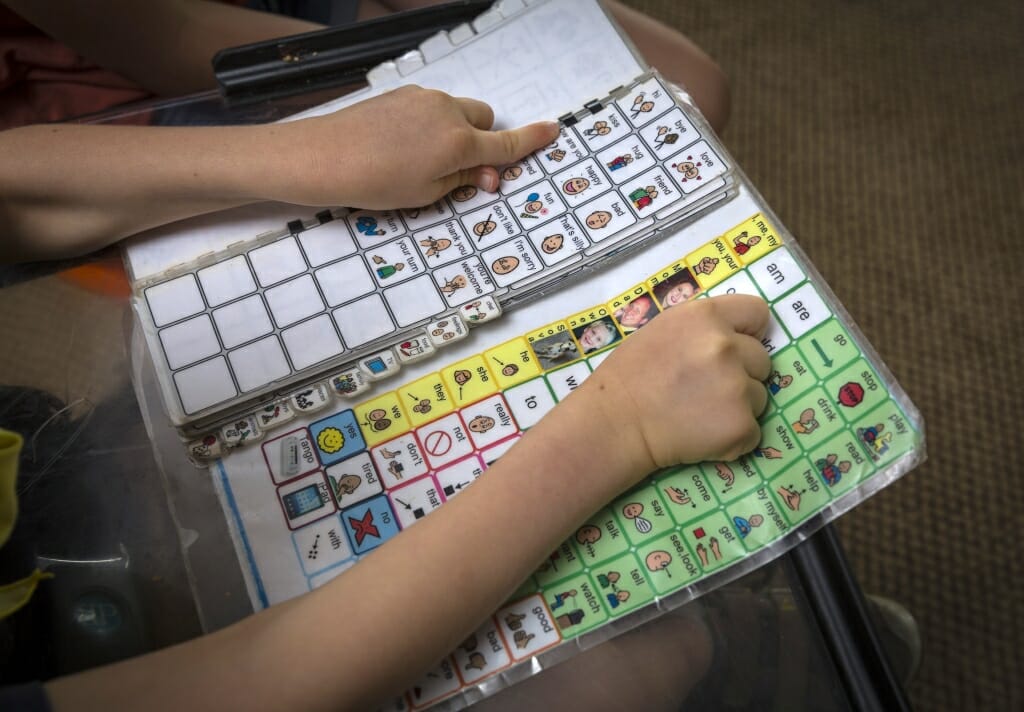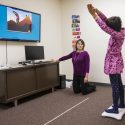Study offers first look at how children with cerebral palsy develop language skills

The Hustad lab studies how speech, language, and communication abilities develop and change as children with cerebral palsy grow up. Courtesy of the Hustad Lab
A new study of children with cerebral palsy could help ease the speech and language challenges many of these children face as they get older.
Published in the journal Developmental Medicine and Child Neurology, it is the first to show that language comprehension skills of children with cerebral palsy can accurately predict their language skills later in life.
“This means that if we identify children with cerebral palsy as young as 24 to 30 months who are very likely to have significant language problems later in life, we may be able to change or improve the course of their development through very early speech-language therapy,” says lead author Katherine Hustad, a professor and chair of the Department of Communications Sciences and Disorders at UW–Madison.
Cerebral palsy is the most common cause of severe motor disability in children, affecting movement, coordination and communication skills. Up to 75 percent of children with cerebral palsy may face challenges communicating.
Many children with cerebral palsy do not receive appropriate speech and language intervention until they enter preschool because very little quantitative data is available about the speech and language difficulties they face. They may be missing critical early intervention opportunities.
Hustad’s research, the culmination of more than 12 years of work at the UW–Madison Waisman Center, is the first to quantitatively show how language comprehension develops over time in young children with cerebral palsy. It also highlights a need to further develop alternative communication tools and testing methods for children with cerebral palsy who also experience more severe communication challenges.

Hustad
For the study, Hustad and colleagues recruited 85 children with cerebral palsy who were born between 2001 and 2009. Some of the children had no difficulties with speech or movement, others had some speech-motor challenges, and a final group had significant speech and communication challenges.
The researchers followed these children from the time they were 18 months old until they were 4.5 years old and tested how well the children understood language at various points as they got older. They found that language comprehension varied between groups.
Children with cerebral palsy who didn’t have speech-motor impairment actually surpassed expectations about language comprehension as they grew older. “They may start out with some delays [compared to typically developing peers], but they catch up and even exceed them over time,” says Hustad.
Children with speech-motor impairment also made age-appropriate progress but a gap remained in their language comprehension levels when compared to typically developing children. “This finding suggests that we may need to target interventions to help these children over this persistent gap,” says Hustad.
The group of children with significant speech and motor issues did not show marked improvement in language comprehension over time. But that may be because we do not yet have the tools to test precisely their ability to comprehend language, says Hustad.
“How we determine what someone knows is by what they tell us and how they answer questions and engage with the world,” says Hustad. “If someone can’t speak and also has a very severe motor impairment and can’t move their arms and legs, it can be almost impossible for us to understand what’s going on inside the mind of that person.”
Hustad is collaborating with fellow Waisman Center investigator and UW–Madison psychology professor Jenny Saffran to develop tests using eye-tracking software that may be better suited to test language comprehension in these children.
While the study did not test whether early interventions in children with cerebral palsy improved their speech and language outcomes, it provides a platform for further work.
“I think our findings from this study and our future work will ultimately help us develop interventions that improve communication and quality of life for children and adults with cerebral palsy,” says Hustad.
Other study authors include Ashley Sakash, Aimee Teo Broman, and Paul Rathouz, UW–Madison professor of biostatistics and medical genetics.
This study was funded by grant R01DC009411 from the National Institute on Deafness and Other Communication Disorders, National Institutes of Health. Support was also provided by a core grant to the Waisman Center, U54 HD090256, from the National Institute of Child Health and Human Development, National Institutes of Health.



